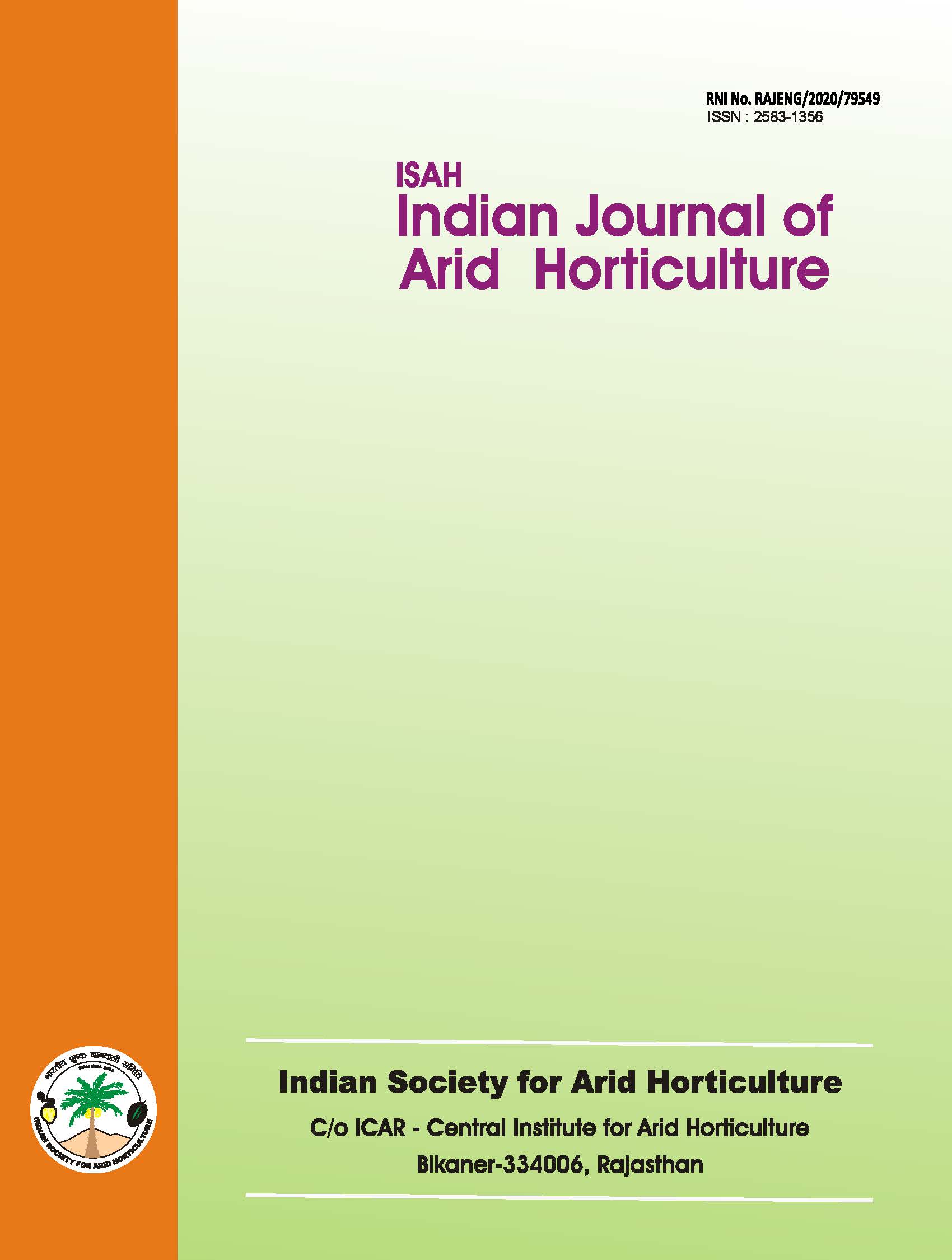Dipcadi erythraeum Webb.& Berth. : A threatened medicinal plant of Thar Desert
Keywords:
Dipcadi erythraeum, conservation, endemic, threatened species, Thar desertAbstract
Dipcadi, an important genus of family Hyacinthaceae is distributed in tropical regions of the world. Most species of Dipcadi are used in folk medicine. Dipcadi erythraeum is one such species of Indian Thar desert, which is traditionally used as food during famine and also as a therapeutic herb. Its over exploitation has reduced its populations and it now it stands as threatened. In this paper, the ecology, potential and need for its in situ conservation in its native sites are highlighted.
Downloads
References
Abdulkareem K.A., Garuba, T., Abdulrasaq, R., Mustapha, O.T. 2014.Studies on the morphology and phytochemical constituents of Dipcadi filamentosa in two states of North-Central Nigeria.J. Chem. Biol. Phys. Sci., 4(3):215864.
Adly, F., Moussaid, M., Berhal, C., Razik, A., Elamrani, A.A., Moussaid, H., Bourhim, N. and Loutfi, M. 2015.Phytochemical screening and biological study
of ethanol extractives of Dipcadi serotinum(L.) Medik. EJARBLS, 3(3):1723.
Ambasta, S.P., Ramchandran, K. and Kashyapa, K. 1986. The Useful Plants of India. Publication and Information Directorate, C.S.I.R, New Delhi.
Bhandari, M.M. 1990. Flora of the Indian desert. M.P.S.
Repros., Rajasthan.
Bhandari, M.M. and Shringii, O.P.1987. Conservationof threatened plants of West Rajasthan. In: S.M.Mohnot and M.M. Bhandari, (ed.): Environmental Degradation in West Rajasthan. University of Jodhpur, Rajasthan.
Dasgupta, S. and Deb, D.B. 1988. Dipcadi cocanenser (Dalz.) Baker, Dipcadi maharashtrensis Deb & Dasgupta, Dipcadi minor Hook.f., Dipcadi reidii Deb & Dasgupta, Dipcadi saxorum Blatter (Liliaceae). In :Nayer, M.P. and A.R.K. Shastri (Eds.) Red Data Book of Indian Plants. Vol 2. BSI, Howarh. pp 175- 181. EL-Shabrawy, M.M., Marzouk, M.M., Kawashty, S.A., Hosni, H.A., EI Garf, I.A.and Saleh, N.A. 2016. Flavonoid constituents of Dipcadi erythraeum Webb. & Berthel. Asian Pacific Journal of Tropical Disease, 6: 404-405.
Jehan, T., Vashishtha, A., Yadav, S.R. and Lakhanpaul, S. 2014. Genetic diversity and genetic relationships in Hyacinthaceae in India using RAPD and SRAP markers. Physiol. Mol. Biol. Plants, 20: 103-114. Jongbloed, M.V.D., Feulner, G.R., Böer, B. and Western, A.R.
The comprehensive guide to thewildflowers of the United Arab Emirates.Environmental Research and Wildlife Development Agency, Abu Dhabi. Joshi, P.N., E.B. Joshi and B.K. Jain. 2012. Ecology and conservation of threatened plants in Tapkeshwari Hill ranges in the Katchch Island, Gujarat. Journal of Threatened Taxa, 4: 2390-2397.
Mandaville, J.P. 1990. Flora of Eastern Saudi Arabia.Kegan
Paul International and NCWCD.
Marzouk, M.M., Elkhateeb, A., Abdel Latif, R.R., Abdel- Hameed, E.S.Kawashty, S.A. and Hussein, S.R. 2019. C-glycosylflavanoid-rich extract of Dipcadi erythraeum Webb &Berthel. Bulbs: Phytochemical and anticancer evaluations. J. Appl. Pharm. Sci., 9(6):94-98.
Mishra, D.K. and N.P. Singh. 2001. Endemic lilies of Maharashtra with their revised red list status. Indian
J. Forestry, 24: 114-118.
Rawat, Deepika, S.K. Sharma, A. Mahmoudi and S.R. Rao. 2011. Cytogenetic rationale for probable amphidiploids origin of Dipacdierythraeum Webb. & Berth.- a rare and endemic plant of Indian Thar Desert. Caryologia, 64: 75-83.
Rawat, D.S. 2009. Dipcadi Medic. (Liliaceae) a disappearing
genus in India. Nat. Acad. Sci. Lett., 32:211-212. Rawat, D.S. and Chandra, S. 2014. Presumed extinct Dipcadi reidii (Asperagaceae) recollected after 127 years from Uttrakhand, India. Rheedea, 24: 1-4.
Rizk, A.M. and El-Ghazaly, G.A. 1995. Medicinal and poisonous plants of Qatar, Scientific and Applied Research Centre, University of Qatar. Sagar, A. and Kasera, P.K. 2016.Phytochemcal analysis in Dipcadi erythraeum during different developmental stages-An endemic and threatened bulbous medicinal plant from the Indian arid zone. The Journal of Indian Botanical Society, 95: 72-75.
Sagar, A. and Kasera, P.K. 2019. Effect of growth regulators on germination of Dipcadi erythraeum, an endemic
and threatened bulbous medicinal plant.Nat. Acad. Sci. Lett. https:/doi.org/10.1007/s40009-018-0763- 6. Vijya Jyothi, M., Salamma, S.,Bhargav, E., Chaitanya, MVNL and Ravi Prasad Rao, B. 2018. Phytochemical screening, anthelmintic and antioxiodant potential of Dipcadi krishnadeverayae (Asparagaceae).International Journal of Pharmacy and Biological Sciences, 8: 332-338.

